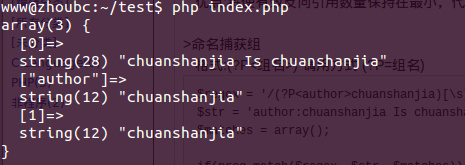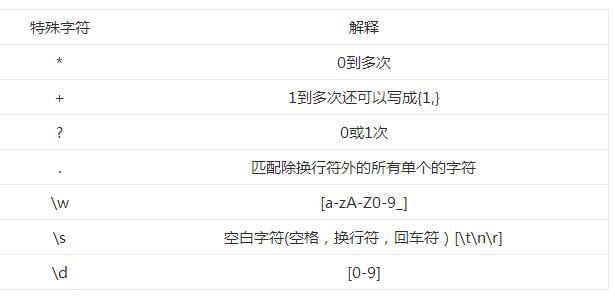没有指明类型而进行的分组,将会被获取,供以后使用。
> 指明类型指的是通配符。所以只有圆括号起始位置没有问号的才能被捕捉。
> 在同一个表达式内的引用叫做反向引用。
> 调用格式: \编号(如\1)。
$regex = '/^(Chuanshanjia)[\w\s!]+\1$/'; $str = 'Chuanshanjia thank Chuanshanjia'; $matches = array(); if(preg_match($regex, $str, $matches)){ var_dump($matches); } echo "\n";
> 避免捕获数据
格式:(?:pattern)
优点:将使有效反向引用数量保持在最小,代码更加、清楚。
>命名捕获组
格式:(?P<组名>) 调用方式 (?P=组名)
$regex = '/(?P<author>chuanshanjia)[\s]Is[\s](?P=author)/i'; $str = 'author:chuanshanjia Is chuanshanjia'; $matches = array(); if(preg_match($regex, $str, $matches)){ var_dump($matches); } echo "\n";
运行结果

惰性匹配(记住:会进行两部操作,请看下面的原理部分)
格式:限定符?
原理:”?”:如果前面有限定符,会使用最小的数据。如“*”会取0个,而“+”会取1个,如过是{3,5}会取3个。
先看下面的两个代码:
代码1.
<?php $regex = '/heL*/i'; $str = 'heLLLLLLLLLLLLLLLL'; if(preg_match($regex, $str, $matches)){ var_dump($matches); } echo "\n";
结果1.

代码2
<?php $regex = '/heL*?/i'; $str = 'heLLLLLLLLLLLLLLLL'; if(preg_match($regex, $str, $matches)){ var_dump($matches); } echo "\n";
结果2

代码3,使用“+”
<?php $regex = '/heL+?/i'; $str = 'heLLLLLLLLLLLLLLLL'; if(preg_match($regex, $str, $matches)){ var_dump($matches); } echo "\n";
结果3

代码4,使用{3,5}
<?php $regex = '/heL{3,10}?/i'; $str = 'heLLLLLLLLLLLLLLLL'; if(preg_match($regex, $str, $matches)){ var_dump($matches); } echo "\n";
结果4

正则表达式的注释
格式:(?# 注释内容)
用途:主要用于复杂的注释
贡献代码:是一个用于连接MYSQL数据库的正则表达式
$regex = '/ ^host=(?<!\.)([\d.]+)(?!\.) (?#主机地址) \| ([\w!@#$%^&*()_+\-]+) (?#用户名) \| ([\w!@#$%^&*()_+\-]+) (?#密码) (?!\|)$/ix'; $str = 'host=192.168.10.221|root|123456'; $matches = array(); if(preg_match($regex, $str, $matches)){ var_dump($matches); } echo "\n";
特殊字符

